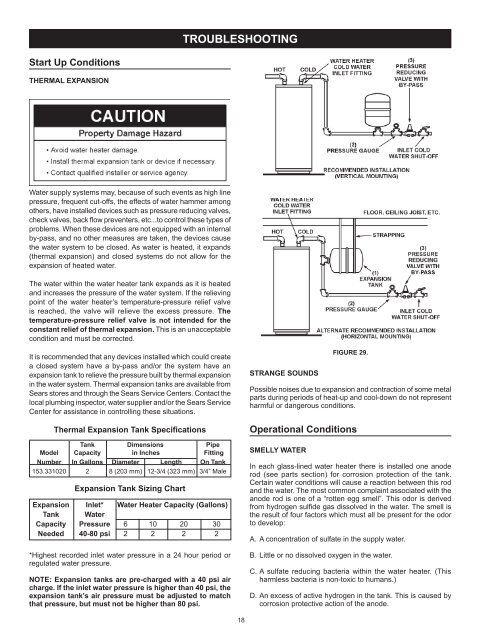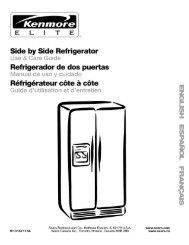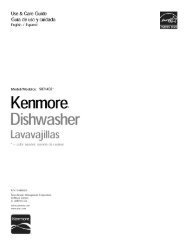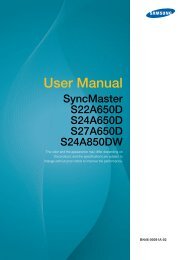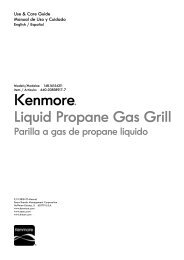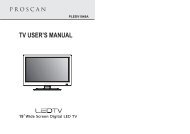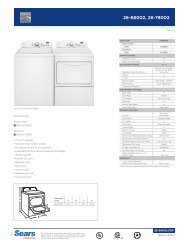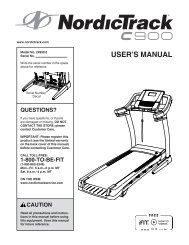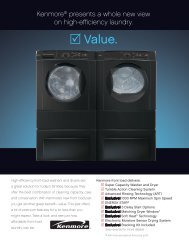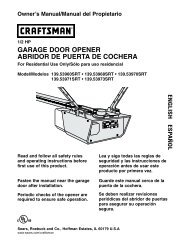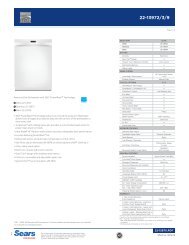the economizer™ 6 compact electric water heater - Sears
the economizer™ 6 compact electric water heater - Sears
the economizer™ 6 compact electric water heater - Sears
Create successful ePaper yourself
Turn your PDF publications into a flip-book with our unique Google optimized e-Paper software.
Start Up Conditions<br />
THERMAL EXPANSION<br />
Water supply systems may, because of such events as high line<br />
pressure, frequent cut-offs, <strong>the</strong> effects of <strong>water</strong> hammer among<br />
o<strong>the</strong>rs, have installed devices such as pressure reducing valves,<br />
check valves, back flow preventers, etc...to control <strong>the</strong>se types of<br />
problems. When <strong>the</strong>se devices are not equipped with an internal<br />
by-pass, and no o<strong>the</strong>r measures are taken, <strong>the</strong> devices cause<br />
<strong>the</strong> <strong>water</strong> system to be closed. As <strong>water</strong> is heated, it expands<br />
(<strong>the</strong>rmal expansion) and closed systems do not allow for <strong>the</strong><br />
expansion of heated <strong>water</strong>.<br />
The <strong>water</strong> within <strong>the</strong> <strong>water</strong> <strong>heater</strong> tank expands as it is heated<br />
and increases <strong>the</strong> pressure of <strong>the</strong> <strong>water</strong> system. If <strong>the</strong> relieving<br />
point of <strong>the</strong> <strong>water</strong> <strong>heater</strong>’s temperature-pressure relief valve<br />
is reached, <strong>the</strong> valve will relieve <strong>the</strong> excess pressure. The<br />
temperature-pressure relief valve is not intended for <strong>the</strong><br />
constant relief of <strong>the</strong>rmal expansion. This is an unacceptable<br />
condition and must be corrected.<br />
It is recommended that any devices installed which could create<br />
a closed system have a by-pass and/or <strong>the</strong> system have an<br />
expansion tank to relieve <strong>the</strong> pressure built by <strong>the</strong>rmal expansion<br />
in <strong>the</strong> <strong>water</strong> system. Thermal expansion tanks are available from<br />
<strong>Sears</strong> stores and through <strong>the</strong> <strong>Sears</strong> Service Centers. Contact <strong>the</strong><br />
local plumbing inspector, <strong>water</strong> supplier and/or <strong>the</strong> <strong>Sears</strong> Service<br />
Center for assistance in controlling <strong>the</strong>se situations.<br />
Thermal Expansion Tank Specifications<br />
Tank Dimensions Pipe<br />
Model Capacity in Inches Fitting<br />
Number In Gallons Diameter Length On Tank<br />
153.331020 2 8 (203 mm) 12-3/4 (323 mm) 3/4” Male<br />
Expansion Tank Sizing Chart<br />
Expansion Inlet* Water Heater Capacity (Gallons)<br />
Tank Water<br />
Capacity Pressure 6 10 20 30<br />
Needed 40-80 psi 2 2 2 2<br />
*Highest recorded inlet <strong>water</strong> pressure in a 24 hour period or<br />
regulated <strong>water</strong> pressure.<br />
NOTE: Expansion tanks are pre-charged with a 40 psi air<br />
charge. If <strong>the</strong> inlet <strong>water</strong> pressure is higher than 40 psi, <strong>the</strong><br />
expansion tank’s air pressure must be adjusted to match<br />
that pressure, but must not be higher than 80 psi.<br />
TROUBLESHOOTING<br />
8<br />
STRANGE SOUNDS<br />
FIGURE 29.<br />
Possible noises due to expansion and contraction of some metal<br />
parts during periods of heat-up and cool-down do not represent<br />
harmful or dangerous conditions.<br />
Operational Conditions<br />
SMELLY WATER<br />
In each glass-lined <strong>water</strong> <strong>heater</strong> <strong>the</strong>re is installed one anode<br />
rod (see parts section) for corrosion protection of <strong>the</strong> tank.<br />
Certain <strong>water</strong> conditions will cause a reaction between this rod<br />
and <strong>the</strong> <strong>water</strong>. The most common complaint associated with <strong>the</strong><br />
anode rod is one of a “rotten egg smell”. This odor is derived<br />
from hydrogen sulfide gas dissolved in <strong>the</strong> <strong>water</strong>. The smell is<br />
<strong>the</strong> result of four factors which must all be present for <strong>the</strong> odor<br />
to develop:<br />
A. A concentration of sulfate in <strong>the</strong> supply <strong>water</strong>.<br />
B. Little or no dissolved oxygen in <strong>the</strong> <strong>water</strong>.<br />
C. A sulfate reducing bacteria within <strong>the</strong> <strong>water</strong> <strong>heater</strong>. (This<br />
harmless bacteria is non-toxic to humans.)<br />
D. An excess of active hydrogen in <strong>the</strong> tank. This is caused by<br />
corrosion protective action of <strong>the</strong> anode.


